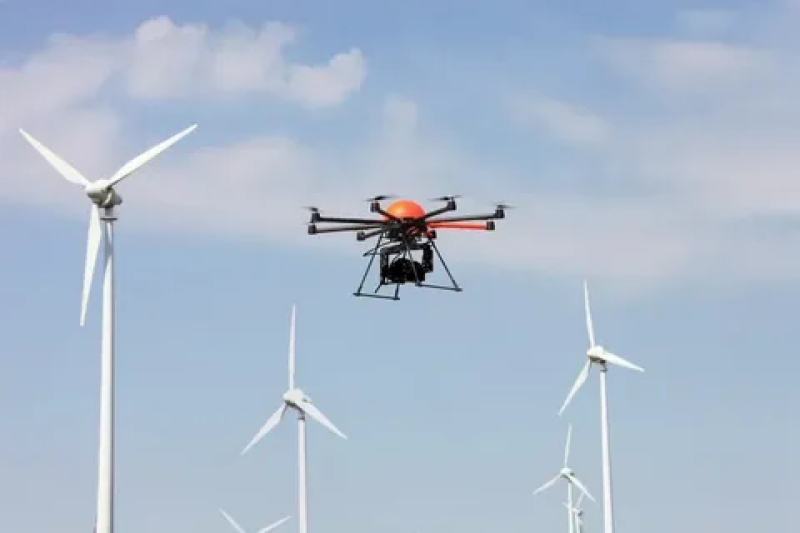Wind energy has become an integral part of the global renewable energy transition, and maintaining wind turbines efficiently is critical to maximizing their operational performance. Traditional inspection methods often involve manual checks or rope access techniques, which are time-consuming, dangerous, and costly. The advent of wind turbine inspection drones has revolutionized this domain, offering a safer, faster, and more cost-effective solution to turbine maintenance and monitoring.
Cutting-Edge Technology Driving Wind Turbine Inspection Drones
Wind Turbine Inspection Drones are equipped with state-of-the-art technology, including high-resolution cameras, thermal imaging sensors, LiDAR systems, and artificial intelligence-driven analytics. These drones fly close to turbine blades and towers, capturing detailed images and data that reveal structural defects such as cracks, erosion, lightning strikes, and corrosion. Thermal imaging is particularly useful in identifying overheating components in electrical systems, enabling early detection of potential failures.
The integration of AI and machine learning algorithms further enhances the accuracy and efficiency of inspections by automating defect recognition and prioritizing maintenance needs. This intelligent data processing reduces human error and allows maintenance teams to focus resources on critical issues, ultimately extending turbine lifespan and cutting operational expenses.
Key Benefits of Using Drones for Wind Turbine Inspections
Using drones for wind turbine inspections offers multiple operational advantages over conventional methods. Primarily, drones eliminate the risk inherent in manual inspections, which often require technicians to climb hundreds of feet using harnesses and ropes. This safety improvement significantly reduces workplace accidents and associated costs.
In addition, drone inspections allow for quicker turnaround times. A drone can complete a full turbine scan in under an hour, whereas traditional visual inspections can take several hours or even days per turbine, especially under adverse weather conditions. This expedited process reduces turbine downtime, ensuring continuous power generation.
Moreover, drones provide access to hard-to-reach areas, enabling comprehensive data collection from all parts of the turbine, including rotor blades, nacelles, and towers. With real-time data transmission capabilities, maintenance teams receive instant feedback, streamlining decision-making and repair scheduling.
Navigating Wind Turbine Drone Market Trends and Industry Developments
The wind turbine inspection drone industry is evolving rapidly with continuous advancements in drone capabilities, regulatory frameworks, and service offerings. Market research reports indicate a growing adoption of automated and autonomous drone inspections driven by increasing offshore and onshore wind installations globally.
Advanced drones now support extended flight times, greater payload capacities for multiple sensors, and enhanced GPS and obstacle avoidance systems. Commercial players are expanding their service portfolios to include predictive maintenance solutions, integrating drone inspection data with digital twin models of wind turbines.
Navigating these market trends provides strategic insights into competitive positioning, technology innovations, and potential service partnerships. In-depth analysis of this emerging market helps stakeholders understand investment opportunities and technological disruptions shaping the future of turbine maintenance.
Commercial Applications of Inspection Drones in Wind Energy Sector
The commercial deployment of wind turbine inspection drones spans a wide array of use cases beyond routine maintenance checks. Energy companies leverage drones for post-storm damage assessments and insurance documentation, which expedites claims and minimizes turbine downtime. Additionally, drones facilitate condition-based maintenance strategies, replacing scheduled inspections with data-driven interventions that lower costs and improve asset reliability.
Service providers offer fully integrated drone inspection contracts, including data analysis, report generation, and maintenance planning support. This end-to-end service model helps operators optimize asset management without investing in expensive drone hardware or specialized staff training.
Furthermore, as the scaled adoption of offshore wind farms grows, drones capable of remote operation and long-range flights are becoming essential. These platforms effectively reduce reliance on costly manned vessels and helicopters traditionally used for offshore inspections.
Transactional Insights: Procuring Wind Turbine Inspection Drone Services
When considering the acquisition of wind turbine inspection drone solutions, companies evaluate factors such as drone technology specifications, on-site service capabilities, data processing and reporting quality, as well as compliance with aviation regulations. Contracts may vary from one-off inspections to long-term service agreements that include continuous monitoring and predictive maintenance analytics.
Procurement processes often involve due diligence on service providers’ technological expertise, customization options, and scalability of solutions. Buyers seek drones with multi-sensor payloads to maximize inspection fidelity and improve actionable insights. Additionally, turnkey software platforms enabling seamless integration of inspection data into enterprise asset management systems are increasingly valued.
Many organizations prioritize service providers offering comprehensive safety protocols and certifications to meet industry standards, ensuring inspections are conducted efficiently without interrupting turbine operations. Transparent pricing models and proof of demonstrated return on investment also play pivotal roles in vendor selection.
Get This Report in Japanese Language: 風力タービン点検ドローン
Get This Report in Korean Language: 풍력 터빈 검사 드론
Read More Articles Related to this Industry- Offshore Wind Industry Analysis – Surging Investment in Renewable Energy Drives Demand
About Author:
Ravina Pandya, Content Writer, has a strong foothold in the market research industry. She specializes in writing well-researched articles from different industries, including food and beverages, information and technology, healthcare, chemical and materials, etc. (https://www.linkedin.com/in/ravina-pandya-1a3984191)
